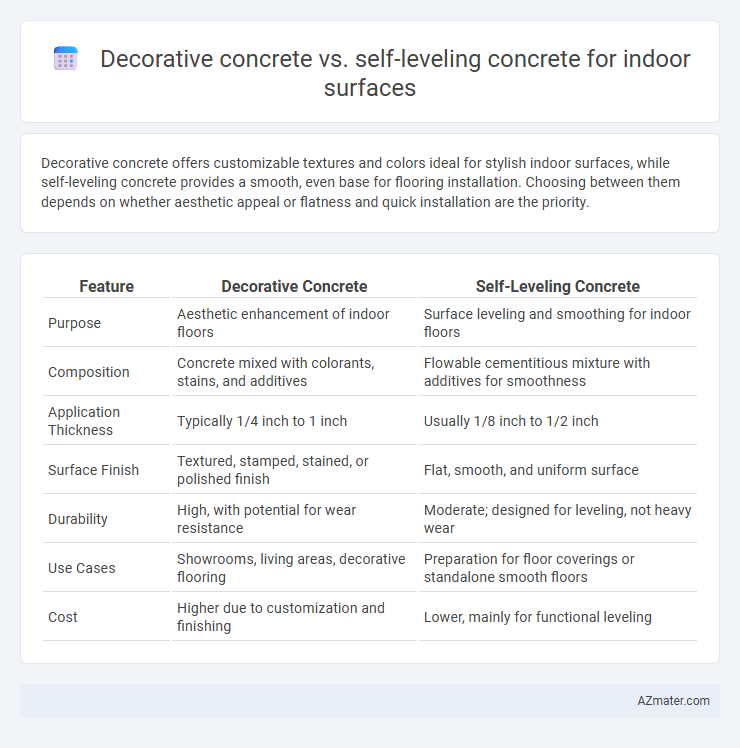Decorative concrete offers customizable textures and colors ideal for stylish indoor surfaces, while self-leveling concrete provides a smooth, even base for flooring installation. Choosing between them depends on whether aesthetic appeal or flatness and quick installation are the priority.
Table of Comparison
| Feature | Decorative Concrete | Self-Leveling Concrete |
|---|---|---|
| Purpose | Aesthetic enhancement of indoor floors | Surface leveling and smoothing for indoor floors |
| Composition | Concrete mixed with colorants, stains, and additives | Flowable cementitious mixture with additives for smoothness |
| Application Thickness | Typically 1/4 inch to 1 inch | Usually 1/8 inch to 1/2 inch |
| Surface Finish | Textured, stamped, stained, or polished finish | Flat, smooth, and uniform surface |
| Durability | High, with potential for wear resistance | Moderate; designed for leveling, not heavy wear |
| Use Cases | Showrooms, living areas, decorative flooring | Preparation for floor coverings or standalone smooth floors |
| Cost | Higher due to customization and finishing | Lower, mainly for functional leveling |
Introduction to Decorative Concrete and Self-Leveling Concrete
Decorative concrete enhances indoor surfaces using techniques like stamping, staining, and polishing to create visually appealing textures and patterns, offering durability and customization. Self-leveling concrete is a polymer-modified, flowable cementitious material designed to create smooth, level floors quickly and efficiently, ideal for repairing uneven indoor surfaces before final flooring installation. Both materials cater to different needs: decorative concrete focuses on aesthetics and design, while self-leveling concrete ensures functional surface preparation and flatness.
Key Differences Between Decorative and Self-Leveling Concrete
Decorative concrete enhances indoor surfaces with customizable aesthetics through stains, stamps, and textures, offering a visually appealing finish suitable for high-traffic areas. Self-leveling concrete prioritizes functionality by providing a smooth, flat substrate designed to correct uneven floors before applying final floor coverings, ensuring durability and ease of installation. While decorative concrete emphasizes design versatility, self-leveling concrete focuses on surface preparation and structural uniformity.
Applications of Decorative Concrete in Indoor Spaces
Decorative concrete offers versatile design options for indoor surfaces, such as polished floors, stamped patterns, and colored overlays that enhance aesthetic appeal in residential and commercial spaces. Its applications include creating customized textures and finishes in living rooms, kitchens, retail stores, and office environments, providing durability and easy maintenance. Compared to self-leveling concrete, decorative concrete emphasizes visual impact while maintaining functional performance on interior floors, walls, and countertops.
Common Uses for Self-Leveling Concrete Indoors
Self-leveling concrete is commonly used indoors for creating smooth, flat surfaces on floors before the installation of final flooring materials such as tiles, hardwood, or carpet. It effectively fills in low spots and repairs uneven slabs, providing a durable and level base ideal for high-traffic areas in residential and commercial buildings. Unlike decorative concrete, which emphasizes aesthetic finishes, self-leveling concrete prioritizes functionality and surface preparation in interior environments.
Surface Preparation Requirements
Decorative concrete for indoor surfaces demands extensive surface preparation, including thorough cleaning, crack repair, and priming to ensure adhesion and enhance aesthetic appeal. Self-leveling concrete requires a smooth, dust-free substrate with minimal moisture and often benefits from a primer to promote flow and bonding on uneven or porous floors. Proper surface profiling and moisture tests are critical for both types to prevent delamination and achieve durable, high-quality finishes.
Aesthetic Possibilities: Decorative vs Self-Leveling Concrete
Decorative concrete offers extensive aesthetic possibilities through customizable colors, patterns, and textures, enabling unique, artistic indoor surfaces that mimic natural stone, wood, or intricate designs. Self-leveling concrete prioritizes smoothness and uniformity, providing a sleek, modern finish ideal for minimalist interiors but limited in decorative options. While decorative concrete enhances visual appeal with various finishing techniques, self-leveling concrete excels in functionality with a clean, consistent look.
Durability and Maintenance Considerations
Decorative concrete offers enhanced durability through surface treatments like acid staining and sealing, which provide resistance to wear and tear while requiring periodic resealing to maintain appearance and protect against stains. Self-leveling concrete provides a smooth, uniform surface that resists cracking and is highly durable for heavy foot traffic but may need regular cleaning to prevent surface wear and maintain its finish. Maintenance for decorative concrete focuses on preserving aesthetic appeal and structural integrity, whereas self-leveling concrete emphasizes surface upkeep and prompt repair of any damage to extend lifespan.
Cost Comparison: Decorative Concrete vs Self-Leveling Concrete
Decorative concrete typically costs between $3 to $12 per square foot, depending on the design complexity, coloring, and finishes, making it a versatile option for upscale indoor surfaces. Self-leveling concrete usually ranges from $2 to $5 per square foot, offering a more affordable solution primarily used for creating smooth, level substrates beneath flooring materials. While decorative concrete involves higher initial expenses due to customization and labor, self-leveling concrete provides cost-effective functionality with faster installation times.
Installation Process and Timeline
Decorative concrete installation involves intricate stamping, staining, or polishing techniques that typically require skilled labor and a longer timeline, often spanning several days to ensure proper curing and detailing. Self-leveling concrete uses a fast-setting, flowable material that spreads evenly over indoor surfaces, significantly reducing installation time to just a few hours and allowing quicker access for subsequent flooring tasks. Choosing between these options depends on the desired aesthetic complexity and project timeline constraints.
Choosing the Right Concrete Solution for Indoor Surfaces
Decorative concrete offers customized aesthetics with options like stamped or stained finishes, ideal for creating visually appealing indoor surfaces that combine durability and style. Self-leveling concrete provides a smooth, flat base quickly, making it perfect for underlayment and ensuring precise flooring installation without height variations. Selecting between decorative and self-leveling concrete depends on whether the priority is surface appearance or functional base preparation for indoor flooring projects.

Infographic: Decorative concrete vs Self-leveling concrete for Indoor surface
 azmater.com
azmater.com